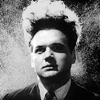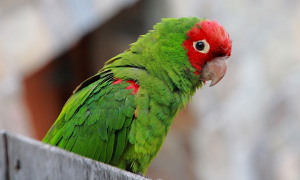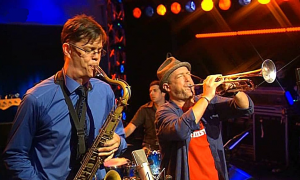Home » Jazz Articles » Genius Guide to Jazz » Terror in G-Sharp
Terror in G-Sharp
Young expounded upon Trambauer's buoyant, breathy sound and created a virtual blueprint of the relaxed sounds of players like Dexter Gordon. Hawkins' big sound and aggressive approach set the stage for later masters like the great John Coltrane and the great John Coltrane, who was so great he deserves to be mentioned twice.
 But then.
But then. The history of the saxophone can be traced back over 150 years with a common lead, or graphite, pencil (actually, it takes several. One pencil is only good for tracing about 32 years). It was invented by and named for Antoine-Joseph (Adolphe) Sax, who invented the instrument to distract attention away from the fact that his name was Antoine-Joseph (Adolphe) Sax. And that name is even funnier if you pronounce the punctuation. Try it. Antoine hyphen Joseph parenthesis Adolphe end parenthesis Sax. Now, try singing it.
Sax took the instrument to famed composer Hector "Boom Boom" Berlioz, who immediately recognized the new horn's magical ability to separate women from their undergarments. Berlioz encouraged Sax to move to Paris where he could use the new instrument to, in his words, "get his freak on." And thus was born the modern era of consensual sodomy laws.
In any event.
Once in Paris, Sax proceeded to introduce his instrument to the rest of the world (and there is absolutely no double entendre there, regardless of the preceding paragraph). Soon, there was entire family of saxophones and an accompanying family portrait by Olan Mills. There were E flat sopranino, F sopranino, B flat soprano, C soprano, E flat alto, F alto, B flat tenor, C tenor, E flat baritone, B flat bass, C bass, E flat contrabass, and F contrabass saxophones. There was also the extremely rare and valuable M sharp saxophone, only one of which exists because immediately after the prototype was made, someone explained to the instrument maker that not only was there was no such key as M sharp, but a saxophone wasn't supposed to be square.
Such as that is.
The saxophone came into its own in 1845. This was the year that Sax took a group of his own forming into competition against the French Army Band. Sax's smaller group overwhelmed the more established group, which was still using traditional instrumentation. Some music historians feel that the victory was due to Sax's use of his new instrument to bring a fuller, more balanced sound to the standard ensemble; others feel that the French mistook Sax, who was Belgian, for German and surrendered to him unconditionally. Either way, a win's a win.
With the instrument firmly established, Sax was able to retire and eventually become the patron saint of every guy who got some leg solely because he played the saxophone. However, Sax will not be recognized as an official saint because of the absence of an otherwise inexplicable miracle. And I know what you're thinking. Dave Koz achieved his popularity because of an unrelated pact with Satan, not because of intervention from St. Antoine hyphen Joseph. Boots Randolph, on the other hand...
Moving along.
 For almost 75 years, the saxophone was considered too "sweet" for dance music. After a few modifications, the horn took on the throatier, more humanesque phrasing now associated with it and took its place in popular music. Among the first and most influential practitioners of the saxophone in popular music was Frankie Trambauer (also spelled Trumbauer, and Traumbauer. Your choice of any two).
For almost 75 years, the saxophone was considered too "sweet" for dance music. After a few modifications, the horn took on the throatier, more humanesque phrasing now associated with it and took its place in popular music. Among the first and most influential practitioners of the saxophone in popular music was Frankie Trambauer (also spelled Trumbauer, and Traumbauer. Your choice of any two).An exceptionally large raccoon raised by the Trambauer family in Carbondale, Illinois, he exhibited an early aptitude for the C-melody saxophone. Soon recording with the Jean Goldkette Orchestra, his light, intellectual style proved to be an inspiration for later, equally influential players like Lester Young and Coleman Hawkins.
Speaking of whom.
It could be said that much of the body of jazz saxophone since the thirties is an amalgam of different concentrations of Young and Hawkins. Young expounded upon Trambauer's buoyant, breathy sound and created a virtual blueprint of the relaxed sounds of players like Dexter Gordon. Hawkins' big sound and aggressive approach set the stage for later masters like the great John Coltrane and the great John Coltrane, who was so great he deserves to be mentioned twice.
 On these foundations came the revolutionary sound of Charlie "Bird" Parker (so nicknamed because it was believed he could actually fly. This was not the case. He could only glide for short distances, much like a so-called flying squirrel. But Charlie "Flying Squirrel" Parker just didn't have the same ring to it). Parker combined both blazing technical ability with an innovative sense of tonal relationships. Using arpeggios of the underlying chords in his solos, not merely confining himself to the notes in and around the melodic theme, Parker seriously increased the syllable count of the paragraphs describing his playing.
On these foundations came the revolutionary sound of Charlie "Bird" Parker (so nicknamed because it was believed he could actually fly. This was not the case. He could only glide for short distances, much like a so-called flying squirrel. But Charlie "Flying Squirrel" Parker just didn't have the same ring to it). Parker combined both blazing technical ability with an innovative sense of tonal relationships. Using arpeggios of the underlying chords in his solos, not merely confining himself to the notes in and around the melodic theme, Parker seriously increased the syllable count of the paragraphs describing his playing. With the advent of Be-Bop, the saxophone came into its own as a true lead instrument. Brilliant players like John Coltrane and Sonny Rollins exploded the boundaries of the instrument, reaching beyond what anyone else had even previously considered. Both Coltrane and Rollins seemed to have a spiritual connection with their instruments, an unseen force driving their relentless vision quests. There were moments when Coltrane seemed rapt in a state of ecstasy, speaking in tongues through his horn like a Pentecostal camp meeting preacher. Rollins seemed immersed in a personal journey towards perfection with the fervent intensity of a 12th-century monastic. And I pretty much emptied my "serious writer" guns on that paragraph.
Give me a moment to unfurrow my brow.
By the later part of the 1950's, there emerged a "Cool" school of jazz that placed less emphasis on the pyrotechnics of the masterful Bop players and concentrated more on clean, melodic lines as if Frankie Trambauer and Lester Young had been suddenly rediscovered. Stan Getz, Wayne Shorter and Paul Desmond embodied the breathy, uncomplicated style that didn't take a degree from Julliard just to whistle.
Beginning with Coltrane's increasingly atonal experiments and Ornette Coleman's no-rules exploration of so-called Free jazz, there emerged an almost underground movement of iconoclastic players who seemed to view the saxophone less as an instrument of jazz than a tool of anarchy. Pharaoh Sanders and Archie Shepp, besides sounding like a pair of hip, bad-assed detectives from a disco-era blaxploitation film, took the saxophone to places few have dared to venture since. In fact, most of those places have since been delisted from the Fodor's Travel Guide.
Cruising into the seventies in a tricked-out El Camino with Bitch's Brew cranking on the eight track, we find the state of jazz saxophone in serious disrepair. With no dominant central figure, like Parker and Coltrane in past decades, the saxophone is almost lost in the overproduced gloss of the disco era. It is perhaps only the return of Dexter Gordon from a self-imposed exile in Europe that saved the saxophone from being relegated to the status of a background instrument in top-forty songs that make sophomore girls feel all tingly.
But then.
 It is perhaps from Gordon's triumphant return in the seventies that set the stage for the hard bop revival of the eighties. Gordon would once again cap it off with an Academy Award-nominated appearance in the movie 'Round Midnight , in which Gordon played an American expatriate living in Paris. Though Gordon actually was, at one time, an American expatriate living in Paris, the film was not autobiographical. In typical Hollywood fashion, it was loosely based on the lives of Lester Young and Bud Powell. It was also proposed to make a film based on the life of Dexter Gordon, starring Bud Powell and Lester Young (one on top of the other's shoulders). Undaunted by the fact that Powell and Young were dead, the project went ahead and with a few slight modifications, became the eighties box-office hit Terminator 2.
It is perhaps from Gordon's triumphant return in the seventies that set the stage for the hard bop revival of the eighties. Gordon would once again cap it off with an Academy Award-nominated appearance in the movie 'Round Midnight , in which Gordon played an American expatriate living in Paris. Though Gordon actually was, at one time, an American expatriate living in Paris, the film was not autobiographical. In typical Hollywood fashion, it was loosely based on the lives of Lester Young and Bud Powell. It was also proposed to make a film based on the life of Dexter Gordon, starring Bud Powell and Lester Young (one on top of the other's shoulders). Undaunted by the fact that Powell and Young were dead, the project went ahead and with a few slight modifications, became the eighties box-office hit Terminator 2. Which is neither here nor there.
 So here we come to the nineties. This is, of course, the era of Kenny G (the G stands for "Good Lord, please make him stop"). A technically competent musician whose lack of soul is so profound that he actually seems to suck the soul out of everything around him like some sort of soft pop black hole (live on pay-per-view this month: The Soft Pop Black Hole versus the Giant Lollipop of the Apocalypse! Call your cable operator to order), Kenny G's main crimes against humanity consist not so much of making insipid, corporately homogenized elevator music and passing it off as jazz. Instead, he has created the terrible moment when an otherwise well-intentioned soul tries to establish some common ground with a true jazz aficionado. "Oh, you like jazz? I love Kenny G." At which point, they must be killed. Thus, Kenny G is responsible for the deaths of hundreds of innocent people and must be brought to justice. I am prepared to offer AAJ's customary reward (your choice of $4 cash, or a largely uneaten pimento cheese sandwich) to whoever can deliver this dangerous villain to the proper authorities. Double that reward for delivering him to the improper authorities, which would be a lot more fun.
So here we come to the nineties. This is, of course, the era of Kenny G (the G stands for "Good Lord, please make him stop"). A technically competent musician whose lack of soul is so profound that he actually seems to suck the soul out of everything around him like some sort of soft pop black hole (live on pay-per-view this month: The Soft Pop Black Hole versus the Giant Lollipop of the Apocalypse! Call your cable operator to order), Kenny G's main crimes against humanity consist not so much of making insipid, corporately homogenized elevator music and passing it off as jazz. Instead, he has created the terrible moment when an otherwise well-intentioned soul tries to establish some common ground with a true jazz aficionado. "Oh, you like jazz? I love Kenny G." At which point, they must be killed. Thus, Kenny G is responsible for the deaths of hundreds of innocent people and must be brought to justice. I am prepared to offer AAJ's customary reward (your choice of $4 cash, or a largely uneaten pimento cheese sandwich) to whoever can deliver this dangerous villain to the proper authorities. Double that reward for delivering him to the improper authorities, which would be a lot more fun. But I digress.
We end up with the question, "Where is the saxophone today?" If only we had had the forethought to put a GPS on the saxophone, we could tell you exactly where it is today. Just like I can tell you that my ex-girlfriend is heading south on Route 220 at this very moment (and thus, maintaining the terms of the restraining order). But, hindsight is 20-20. What matters is that the saxophone is safely in the hands of such talented musicians as Joshua Redman, who took up the saxophone after making his fortune in the chewing tobacco trade (as did pioneering jazzmen Levi Garrett and Bob Beechnut before him). And somewhere, St. Antoine hyphen Joseph is looking down on this article and smiling, as he phones his attorney to ask about defamation of character suits from beyond the grave.
Till next month, exit to your right and enjoy the rest of AAJ.
[In case you're wondering why I never once referred to the saxophone as a "sax," it is because I didn't want any horny, semi-literate dullards stumbling across this page as a result of a misspelled Yahoo search and e-mailing me for naked pictures of Britney Spears. And I think I may have dislocated my rotator cuff reaching for that gag.]
< Previous
Ebony and Ivory and Ted and Alice
Comments
Tags
For the Love of Jazz
 All About Jazz has been a pillar of jazz since 1995, championing it as an art form and, more importantly, supporting the musicians who create it. Our enduring commitment has made "AAJ" one of the most culturally important websites of its kind, read by hundreds of thousands of fans, musicians and industry figures every month.
All About Jazz has been a pillar of jazz since 1995, championing it as an art form and, more importantly, supporting the musicians who create it. Our enduring commitment has made "AAJ" one of the most culturally important websites of its kind, read by hundreds of thousands of fans, musicians and industry figures every month.






















